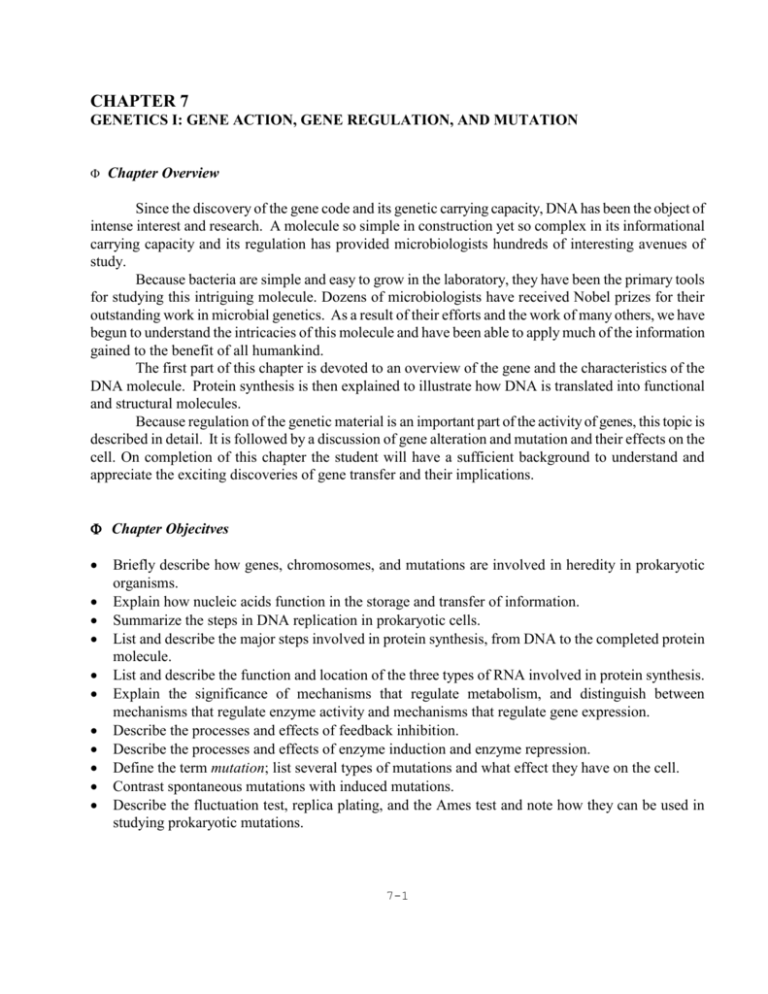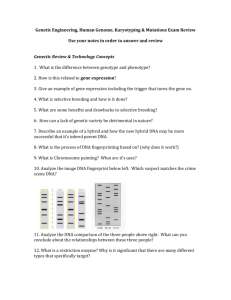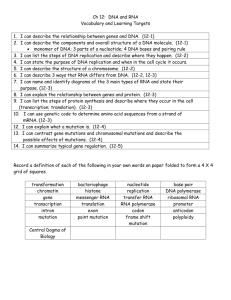Chapter 7 Microbial genetics
advertisement

CHAPTER 7 GENETICS I: GENE ACTION, GENE REGULATION, AND MUTATION Chapter Overview Since the discovery of the gene code and its genetic carrying capacity, DNA has been the object of intense interest and research. A molecule so simple in construction yet so complex in its informational carrying capacity and its regulation has provided microbiologists hundreds of interesting avenues of study. Because bacteria are simple and easy to grow in the laboratory, they have been the primary tools for studying this intriguing molecule. Dozens of microbiologists have received Nobel prizes for their outstanding work in microbial genetics. As a result of their efforts and the work of many others, we have begun to understand the intricacies of this molecule and have been able to apply much of the information gained to the benefit of all humankind. The first part of this chapter is devoted to an overview of the gene and the characteristics of the DNA molecule. Protein synthesis is then explained to illustrate how DNA is translated into functional and structural molecules. Because regulation of the genetic material is an important part of the activity of genes, this topic is described in detail. It is followed by a discussion of gene alteration and mutation and their effects on the cell. On completion of this chapter the student will have a sufficient background to understand and appreciate the exciting discoveries of gene transfer and their implications. Chapter Objecitves Briefly describe how genes, chromosomes, and mutations are involved in heredity in prokaryotic organisms. Explain how nucleic acids function in the storage and transfer of information. Summarize the steps in DNA replication in prokaryotic cells. List and describe the major steps involved in protein synthesis, from DNA to the completed protein molecule. List and describe the function and location of the three types of RNA involved in protein synthesis. Explain the significance of mechanisms that regulate metabolism, and distinguish between mechanisms that regulate enzyme activity and mechanisms that regulate gene expression. Describe the processes and effects of feedback inhibition. Describe the processes and effects of enzyme induction and enzyme repression. Define the term mutation; list several types of mutations and what effect they have on the cell. Contrast spontaneous mutations with induced mutations. Describe the fluctuation test, replica plating, and the Ames test and note how they can be used in studying prokaryotic mutations. 7-1 Animations, videos and tutorials – online A. This site provides an interactive animated tutorial on DNA structure and provides links to other sites. http://www.umass.edu/molvis/tutorials/dna/ B. John Kryk’s website with animations on DNA anatomy (http://www.johnkyrk.com/DNAanatomy.html), DNA replication (http://www.johnkyrk.com/DNAreplication.html), DNA transcription (http://www.johnkyrk.com/DNAtranscription.html), and RNA translation (http://www.johnkyrk.com/DNAtranslation.html). C. DNA interactive website that has many good tutorials and animations. You can get started by clicking on the links (Timeline, Code, Manipulation, Genome, Applications, or Chronicle) at the top. There are links to other good resources here as well. http://www.dnai.org/index.htm D. Protein synthesis animation http://www.biostudio.com/demo_freeman_protein_synthesis.htm E. Prokaryotic protein synthesis http://www.biostudio.com/d_%20Protein%20Synthesis%20Prokaryoti c.htm F. UV induced photodimers and excision repair http://www.biostudio.com/d_%20UV%20Induced%20Photodimers%2 0Excision%20Repair.htm G. The lac operon http://www.biostudio.com/d_%20Lac%20Operon.htm H. Annenberg Foundation (registration required) on Reading the Code of Life - http://www.learner.org/vod/vod_window.html?pid=1366 Web Destinations http://microbialgenome.org/index.shtml Department of Energy microbial genomics web site http://www.dnaftb.org/ This site, provided by the Josiah Macy, Jr. Foundation, offers an animated primer on the basics of DNA, genes, and heredity http://cellbio.com Information resource for cell and molecular biology http://www.ncc.gmu.edu/dna/ George Mason University online tutorial on DNA replication and protein synthesis http://morgan.rutgers.edu/morganwebframes/How_To_Use/HTU_frameset.html Rutgers University DNA tutorial (registration required) 7-2 Discussion Topics (aka. Future Exam Essay Questions) How do we know for sure that DNA and not some other molecule such as a protein or an enzyme is the material responsible for carrying the characteristics of an organism? Why are microbes so well suited for the study of mutations? How can nucleotide base analogs and ionizing radiation, which can cause mutations, be used in the treatment of cancers? Chapter Outline I. Overview of Genetic Processes A. Basis of heredity 1. Chromosome 2. DNA 3. Genes 4. Mutations B. Nucleic acids in information storage and transfer 1. Information storage 2. Information transfer a. Transcription b. Translation c. Reverse transcription II. DNA Replication A. Antiparallelism B. Replication forks 1. DNA polymerase 2. Leading strand 3. Lagging strand 4. Okazaki fragments 5. Ligases C. Semiconservative replication III. Protein Synthesis A. Transcription 1. Mechanism 2. RNA polymerase 3. Exons 4. Introns B. Kinds of RNA 1. Ribosomal RNA a. Ribosome components 7-3 C. b. Ribosome structure 2. Messenger RNA a. Codons b. Genetic code 3. Transfer RNA Translation 1. Main steps of protein synthesis 2. Terminator codons IV. Regulation of Metabolism A. Significance of regulatory mechanisms B. Categories of regulatory mechanisms C. Feedback inhibition D. Enzyme Induction 1. Constitutive enzymes 2. Inducible enzymes 3. Operon theory a. Structural genes b. Regulator genes c. lac operon d. Repressor E. Enzyme repression F. Catabolite repression V. Mutations A. Types of mutations and their effects 1. Genotype 2. Phenotype 3. Point mutations 4. Frameshift mutations B. Phenotypic variations 1. Morphological changes 2. Nutritional changes a. Auxotrophic mutants b. Prototrophs C. Spontaneous and induced mutations D. Chemical mutagens 1. Base analogs 2. Alkylating agents 3. Deaminating agents 4. Acridine derivatives E. Radiation as a mutagen 1. X-ray radiation 2. Ultraviolet radiation 3. Restriction endonucleases 7-4 F. G. H. 4. Exonucleases Repair of DNA damage 1. Light repair (photoreactivation) 2. Dark repair 3. Clinical example The study of mutations 1. Basic concepts 2. Fluctuation test 3. Replica plating The Ames test 7-5









